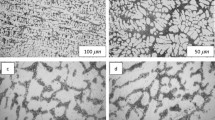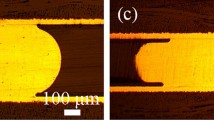Abstract
Lead-free “copper wire/Sn-3.0Ag-0.5Cu (SAC305) solder/copper wire” sandwich-structured micro-scale solder joints with a constant diameter (d = 400 μm) and various heights (125, 225, and 325 μm) were adopted to carried out the mechanical behavior research. Experimentally, quasi-static shear and tensile experiments were conducted by using a precision dynamic mechanics analyzer (DMA Q800). Then, the micro-scale solder joint model was built to simulate shear and tensile behavior of solder joints using the finite element analysis software ABAQUS. The experimental results show that, when the solder joint diameter is fixed, the smaller the joint height is, the stronger the shear strength and tensile strength. Under the same test conditions (225 μm), the shear strength of micro-scale solder joints of the same size is lower than the tensile strength, which indicates that the service environment of electronic packaging interconnection solder joints under shear stress is more severe. In addition, the micro-scale solder joints fracture at the interface of the solder joint and copper wire under shear force, but in the middle of the solder joint under tensile force. Different fracture failure mechanisms are found by observing the cross sections under different stress states.









Similar content being viewed by others
References
Tu KN (2003) Recent advances on electromigration in very-large-scale-integration of interconnects. J Appl Phys 94(9):5451–5473. https://doi.org/10.1063/1.1611263
Fortier A, Pecht M (2017) A perspective of the IPC report on lead-free electronics in military/aerospace applications. Microelectron Reliab 69:66–70. https://doi.org/10.1016/j.microrel.2017.01.001
Zhang L, Han J, He C, Guo Y (2013) Reliability behavior of lead-free solder joints in electronic components. J Mater Sci Mater Electron 24(1):172–190. https://doi.org/10.1007/s10854-012-0720-y
Kong X, Sun F, Yang M (2018) Analysis of creep performance of micro solder joints under different loading mode. Chin. J Mater Res. 32(3):184–190. https://doi.org/10.11901/1005.3093.2018.124
Pecht M, Shibutani T, Wu L (2016) A reliability assessment guide for the transition planning to lead-free electronics for companies whose products are RoHS exempted or excluded. Microelectron Reliab 62(62):113–123. https://doi.org/10.1016/j.microrel.2016.03.020
Zimprich P, Betzwarkotas A, Khatibi G, Weiss B, Ipser H (2008) Size effects in small scaled lead-free solder joints. J Mater Sci Mater Electron 19(4):383–388. https://doi.org/10.1007/s10854-007-9349-7
Orowan E (1949) Fracture and strength of solids. Rep Prog Phys 12(1):185–232. https://doi.org/10.1088/0034-4885/12/1/309
Lee B, Yoon J (2018) Cu-Sn intermetallic compound joints for high-temperature power electronics applications. J Electron Mater 47(1):430–435. https://doi.org/10.1007/s11664-017-5792-2
Qin H, Zhang X, Zhou M, Zeng J, Mai Y (2014) Size and constraint effects on mechanical and fracture behavior of micro-scale Ni/Sn3.0Ag0.5Cu/Ni solder joints. Mat Sci Eng A-Struct 617:14–23. https://doi.org/10.1016/j.msea.2014.08.008
Li B, Zhang X, Yang Y, Yin L, Pecht M (2013) Size and constraint effects on interfacial fracture behavior of microscale solder interconnects. Microelectron Reliab 53(1):154–163. https://doi.org/10.1016/j.microrel.2012.07.033
Cho Y, Jang J, Jang G (2018) Sensitivity analysis on the fatigue life of solid state drive solder joints by the finite element method and Monte Carlo simulation. Microsyst Technol 24(11):4669–4676. https://doi.org/10.1007/s00542-018-3819-0
He X, Yao Y (2017) A dislocation density based viscoplastic constitutive model for lead free solder under drop impact. Int J Solids Struct 120:236–244. https://doi.org/10.1016/j.ijsolstr.2017.05.005
An T, Qin F, Li J (2010) Mechanical behavior of solder joints under dynamic four-point impact bending. Microelectron Reliab 51(5):1011–1019. https://doi.org/10.1016/j.microrel.2010.12.009
Yao Y, Fry J, Fine ME, Keer LM (2013) The Wiedemann–Franz–Lorenz relation for lead-free solder and intermetallic materials. Acta Mater 61(5):1525–1536. https://doi.org/10.1016/j.actamat.2012.11.030
Johnson GR, Cook WH (1985) Fracture characteristics of three metals subjected to various strains, strain rates, temperatures and pressures. Eng Fract Mech 21(1):31–48. https://doi.org/10.1016/0013-7944(85)90052-9
Wong EH, Chrisp J, Selvanayagam CS, Seah SK (2016) Constitutive modeling of solder alloys for drop-impact applications. Microelectron Reliab 67:135–142. https://doi.org/10.1016/j.microrel.2016.10.007
Qin F, An T, Chen N (2010) Strain rate effects and rate-dependent constitutive models of lead-based and lead-free solders. J Appl Mech 77(1):1008. https://doi.org/10.1115/1.3168600
Kim J, Jung S (2007) Design of solder joint structure for flip chip package with an optimized shear test method. J Electron Mater 36(6):690–696. https://doi.org/10.1007/s11664-007-0140-6
Yin L, Zhang X, Lu C (2009) Size and volume effects on the strength of microscale lead-free solder joints. J Electron Mater 38(10):2179–2183. https://doi.org/10.1007/s11664-009-0858-4
Funding
This research was supported by the National Natural Science Foundation of China (No. 51674056), the Frontier and Applied Basic Research Projects of Chongqing (Nos. cstc2018jcyjAX0108 and cstc2019jcyj-msxmX0175), the University Outstanding Achievement Transformation Project of Chongqing (No. KJZH17137), and the Opening Project of Guangdong Provincial Key Laboratory of Modern Welding Technology (No. 2018002).
Author information
Authors and Affiliations
Corresponding author
Additional information
Publisher’s note
Springer Nature remains neutral with regard to jurisdictional claims in published maps and institutional affiliations.
Recommended for publication by Commission XVII - Brazing, Soldering and Diffusion Bonding
Rights and permissions
About this article
Cite this article
Yin, L., Zuo, C., Zhang, Z. et al. Experimental and numerical simulation of mechanical behavior of micro-scale SAC305 solder joint based on joint height. Weld World 64, 2101–2108 (2020). https://doi.org/10.1007/s40194-020-00985-1
Received:
Accepted:
Published:
Issue Date:
DOI: https://doi.org/10.1007/s40194-020-00985-1




